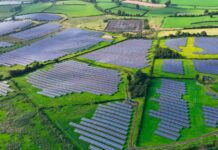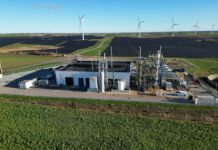
Ultra-low gas-fired power generation, falling demand, and the restart of solar generation build-out characterized Britain’s electricity market in the second quarter this year, according to a new report by energy data analyst Montel Analytics.
Gas output reduced by over a third in this period to 13.4TWh – the lowest quarterly figure recorded by Montel Analytics in the last 20 years. Gas prices rose steadily, starting the quarter at £23.24/MWh, dipping to a low of £21.26/MWh in early April, then climbing above £23.00/MWh for most of the month. After a brief decline for a few days from May 10 due to a warm spell, prices surged to a peak of £30.06/MWh on June 3 and remained above £26.00/MWh for the rest of the quarter, closing at £27.35/MWh.
Average transmission system demand dipped to 23.5GW, the lowest figure for any Q2 since the first lockdown in 2020. This was attributed in part to milder weather, particularly in May and late June and increased embedded generation from solar and load shifting from batteries and other sources.
Renewables contributed 47% to the GB power generation mix, with wind output (17.2TWh), biomass (6.8TWh), and hydro (1.1TWh) all boosting Britain’s clean energy output during the quarter. Solar generation reached its highest level for any recent quarter, rising from 4.90TWh in Q2 last year to 5.1TWh.
Overall GB power generation (excluding imports) fell 17% from the previous quarter to 54.6TWh, marking the lowest quarterly total since Q2 2022. This reduction was attributable to decreased demand and high levels of imports, which resulted in the steep drop in output from CCGT plants.
Net imports into GB rose to 9.2TWh from 7.4TWh the previous quarter, with most of the power coming from France (6.4TWh).
Phil Hewitt, director at Montel Analytics – which is part of the Montel group – said:
“Solar generation rose by 4% on Q2 last year, which is lower than the previous year-on-year growth in Q2 2023 but this is in the context of some pretty horrible weather. The pattern of demand destruction also continued due in part to warmer weather and people and businesses becoming more conscious of limiting their energy costs.
“Higher levels of net imports resulted in very low gas output, while gas prices increased steadily following a decline in the previous quarter. This rise was driven by several factors including escalating tensions in the Middle East affecting liquid nitrogen gas (LNG) shipments, an earlier-than-expected stop in Russian gas flows to Austria, and reduced supplies from Norway due to maintenance at production facilities.
“Wind output fell from 24.9TWh in the first quarter to 17.2TWh in quarter two. Reductions in wind generation became necessary during windy spells, with bid volumes being used to reduce the excess of available wind generation. Most of the accepted bids occurred during the first three weeks in April and the highest daily bid volume for the quarter of more than 4GW was observed on the morning of June 28 when wind was substantially high.
“The nuclear fleet mostly operated at capacity in this quarter due to the return to service of most units, with only limited outages observed compared to the previous quarter. Consequently, generation increased by 37% on a quarter-on-quarter basis to 10.7TWh, the highest for any quarter since Q3 2022.
“Meanwhile, coal-fired generation fell to 0.3TWh from 1.0TWh in Q1 2024. This decline aligns with the decommissioning of the last coal-fired power station, Ratcliffe-on-Soar, which is scheduled to close on September 30 this year.”
Renewables generation (wind, biomass, solar, and hydro) was the largest contributor to the GB power generation mix during Q2 2024, accounting for 47% of the total output. Gas-fired generation made up 21% of the total, with nuclear (17%), imports (14%), and coal (0.3%) accounting for the rest.






